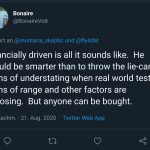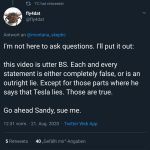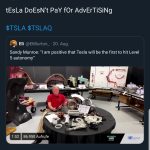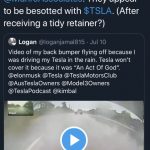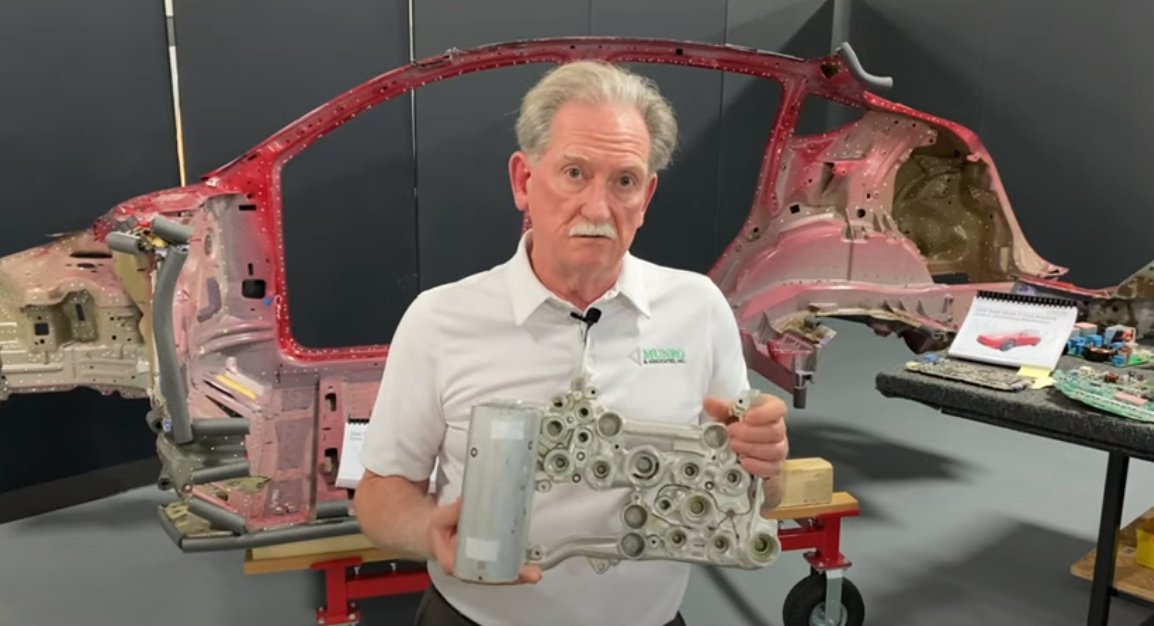
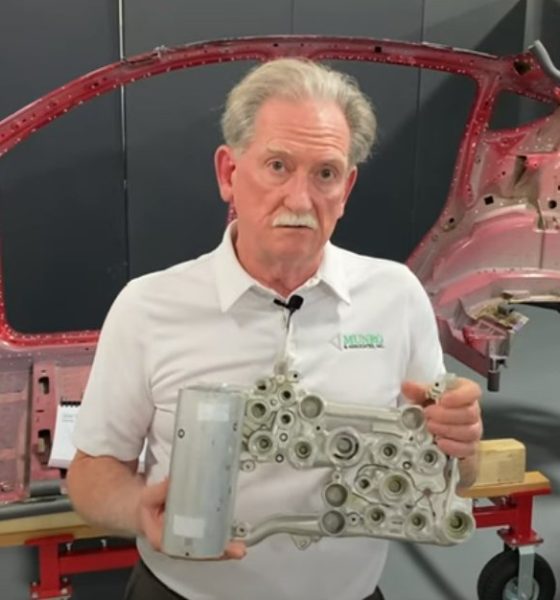
News
Tesla teardown specialist Sandy Munro lays the law on TSLAQ over false allegations
When Sandy Munro started his analysis of an early production Tesla Model 3, he was aghast at the vehicle’s quirks, and he made his disapproval known. Munro did not pull his punches back, pointing out the vehicle’s build quality issues and outlining exactly what was wrong with the all-electric sedan. Yet as soon as his analysis took him beyond the Model 3’s bodywork, Munro found something remarkable: Tesla’s tech was beyond everyone else’s in the automotive industry, and it’s not even close.
By the time he was finished tearing down the Model 3, Munro was already quite impressed with Tesla. Everything, he noted, from the Model 3’s suspension down to its batteries was on point, and the company’s tech was insane. Munro suggested that if Tesla had only paid more attention to its basics like build quality, the electric car maker would have wiped the floor with legacy automakers. These developments could all be reviewed through Munro’s multiple appearances at Autoline After Hours, where he is featured as a guest from time to time.
Munro and his company, Munro and Associates, eventually took on their next Tesla project by tearing down an early production Model Y. The veteran was gracious enough to share his insights on the vehicle through a series that he and his team uploaded on YouTube. The video series documented every step of the Model Y’s teardown process, and while Munro still observed a number of build quality-related points for improvement in the all-electric crossover, he was impressed overall. So impressed, in fact, that Munro opted to share his enthusiasm for the vehicle openly. Recent videos even include “tips” for Tesla that could improve their vehicles further.
#MunroAssociates Tips For #Tesla E3 – Night Vision HUD & Wire Reductionhttps://t.co/WlzodSDwWO pic.twitter.com/5dDEu9LzU9— Munro & Associates (@MunroAssociates) July 25, 2020
This did not sit well with Tesla critics, particularly the online TSLAQ group. Tesla critics and short-sellers are known to propagate the occasional conspiracy theory, whether that involves accusations of abuse by the Tesla CEO to alleged cover-ups by government agencies that are supposedly paid by the electric car maker to do their bidding. Granted, most of these conspiracy theories are just noise, but sometimes, this noise can result in very real repercussions. Unfortunately, this exact thing happened to Sandy Munro.
When it became evident that Munro was openly supportive of Tesla and the Model Y, it did not take long for the TSLAQ Twitter community to insinuate that the teardown expert was actually being paid by the electric car maker for good publicity. Notable short-sellers joined in on the insinuations, TSLAQ trolls dared Munro to file a lawsuit against them, and some members of the media who are known to be critical of the electric car maker brought up the fact that the teardown expert’s stance on Tesla changed over time.
These, of course, neglect to explore one possible explanation for Munro’s shift on his stance about Tesla. While Munro was openly critical of the Model 3 during his first look at the car, he was eventually won over by the tech and innovation that was put into the vehicle. The Model Y, which followed the Model 3, embodied many of Munro’s own points for improvement that he raised during his analysis of the all-electric sedan. Perhaps, just perhaps, Tesla is improving as an automaker, and the company’s electric cars are really in the bleeding edge of automotive tech.
Ever the fighter, Munro has posted a stern response to the insinuations leveled against him by Tesla critics. In a YouTube video, Munro laid down the law on TSLAQ, declaring that neither he nor his company is being paid to talk positively about the electric car maker. And in true Munro fashion, the teardown expert came with evidence, explaining exactly how innovations like the Octovalve are only possible in a company that works like Tesla. Following is his statement.
“Munro and Associates is not, I repeat, is not paid by Tesla to say or do or receive anything that we have. I know that some people are saying things like that. They don’t know what they’re talking about. I have to try and defend myself periodically, and this is it. So, I can tell you a little something right now that the Tesla haters or basically the people that are trying to drive me out of business are saying — that Tesla would never tell you.
“So this is part of the Octovalve. And what we’ve noticed is, we had one of our customers come in with a brand new Tesla. It was built about one month ago and we noticed that their product, the product that you’re seeing here — the aluminum supermanifold — their product had 13 design changes associated with it. Thirteen. I’m going to tell you. I couldn’t get one design change through in a year when I was at Ford Motor Company. They (Tesla) did 13 in three months. That’s why they’re kicking some serious butt.
“Another thing that we found was when we got our vehicle, there was no shroud around the compressor. Their vehicle had an excellent design for a shroud, and it looked spectacular. Now am I saying things that Tesla told me to tell you? I don’t think so… Munro and Associates and myself as the number one associate, we are in this strictly for the right reasons. I am not bought by anyone. No one in this company is bought by anyone. We are a consulting house that tells the truth all the time — good, bad, or ugly — and I’m just starting to find out about this. It’s all crap. Don’t believe any of it.”
Most of the tweets posted online which suggested that Munro was a paid shill for Tesla have already been deleted, though some screenshots of the posts have made the rounds online. It is through these that it was revealed that Sandy Munro has started preparing a lawsuit to hold the TSLAQ members liable for damages, seeing as one of his key clients was affected by the accusations. Based on a message sent by the veteran teardown specialist to a key Tesla critic, it appears that Munro is dead serious, and he is looking to hold those involved in the issue accountable.
Watch Munro’s statement on the allegations in the video below.

Elon Musk
Tesla CEO Elon Musk teases insane capabilities of next major FSD update

Tesla CEO Elon Musk teased the insane capabilities of the next major Full Self-Driving update just hours after the company rolled out version 14.2 to owners.
Tesla Full Self-Driving v14.2 had some major improvements from the previous iteration of v14.1.x. We were on v14.1.7, the most advanced configuration of the v14.1 family, before Tesla transitioned us and others to v14.2.
However, Musk has said that the improvements coming in the next major update, which will be v14.3, will be where “the last big piece of the puzzle finally lands.”
14.3 is where the last big piece of the puzzle finally lands
— Elon Musk (@elonmusk) November 21, 2025
There were some major improvements with v14.2, most notably, Tesla seemed to narrow in on the triggers that caused issues with hesitation and brake stabbing in v14.1.x.
One of the most discussed issues with the past rollout was that of brake stabbing, where the vehicle would contemplate proceeding with a route as traffic was coming from other directions.
We experienced it most frequently at intersections, especially four-way stop signs.
Elon Musk hints at when Tesla can fix this FSD complaint with v14
In our review of it yesterday, it was evident that this issue had been resolved, at least to the extent that we had no issues with it in a 62-minute drive, which you can watch here.
Some owners also reported a more relaxed driver monitoring system, which is something Tesla said it was working on as it hopes to allow drivers to text during operation in the coming months. We did not test this, as laws in Pennsylvania prohibit the use of phones at any time due to the new Paul Miller’s Law, which took effect earlier this year.
However, the improvements indicate that Tesla is certainly headed toward a much more sentient FSD experience, so much so that Musk’s language seems to be more indicative of a more relaxed experience in terms of overall supervision from the driver, especially with v14.3.
Musk did not release or discuss a definitive timeline for the release of v14.3, especially as v14.2 just rolled out to Early Access Program (EAP) members yesterday. However, v14.1 rolled out to Tesla owners just a few weeks ago in late 2025. There is the potential that v14.3 could be part of the coming Holiday Update, or potentially in a release of its own before the New Year.
News
Tesla Full Self-Driving v14.2 – Full Review, the Good and the Bad

Tesla rolled out Full Self-Driving version 14.2 yesterday to members of the Early Access Program (EAP). Expectations were high, and Tesla surely delivered.
With the rollout of Tesla FSD v14.2, there were major benchmarks for improvement from the v14.1 suite, which spanned across seven improvements. Our final experience with v14.1 was with v14.1.7, and to be honest, things were good, but it felt like there were a handful of regressions from previous iterations.
While there were improvements in brake stabbing and hesitation, we did experience a few small interventions related to navigation and just overall performance. It was nothing major; there were no critical takeovers that required any major publicity, as they were more or less subjective things that I was not particularly comfortable with. Other drivers might have been more relaxed.
With v14.2 hitting our cars yesterday, there were a handful of things we truly noticed in terms of improvement, most notably the lack of brake stabbing and hesitation, a major complaint with v14.1.x.
However, in a 62-minute drive that was fully recorded, there were a lot of positives, and only one true complaint, which was something we haven’t had issues with in the past.
The Good
Lack of Brake Stabbing and Hesitation
Perhaps the most notable and publicized issue with v14.1.x was the presence of brake stabbing and hesitation. Arriving at intersections was particularly nerve-racking on the previous version simply because of this. At four-way stops, the car would not be assertive enough to take its turn, especially when other vehicles at the same intersection would inch forward or start to move.
This was a major problem.
However, there were no instances of this yesterday on our lengthy drive. It was much more assertive when arriving at these types of scenarios, but was also more patient when FSD knew it was not the car’s turn to proceed.
Can report on v14.2 today there were ZERO instances of break stabbing or hesitation at intersections today
It was a significant improvement from v14.1.x
— TESLARATI (@Teslarati) November 21, 2025
This improvement was the most noticeable throughout the drive, along with fixes in overall smoothness.
Speed Profiles Seem to Be More Reasonable
There were a handful of FSD v14 users who felt as if the loss of a Max Speed setting was a negative. However, these complaints will, in our opinion, begin to subside, especially as things have seemed to be refined quite nicely with v14.2.
Freeway driving is where this is especially noticeable. If it’s traveling too slow, just switch to a faster profile. If it’s too fast, switch to a slower profile. However, the speeds seem to be much more defined with each Speed Profile, which is something that I really find to be a huge advantage. Previously, you could tell the difference in speeds, but not in driving styles. At times, Standard felt a lot like Hurry. Now, you can clearly tell the difference between the two.
It seems as if Tesla made a goal that drivers should be able to tell which Speed Profile is active if it was not shown on the screen. With v14.1.x, this was not necessarily something that could be done. With v14.2, if someone tested me on which Speed Profile was being used, I’m fairly certain I could pick each one.
Better Overall Operation
I felt, at times, especially with v14.1.7, there were some jerky movements. Nothing that was super alarming, but there were times when things just felt a little more finicky than others.
v14.2 feels much smoother overall, with really great decision-making, lane changes that feel second nature, and a great speed of travel. It was a very comfortable ride.
The Bad
Parking
It feels as if there was a slight regression in parking quality, as both times v14.2 pulled into parking spots, I would have felt compelled to adjust manually if I were staying at my destinations. For the sake of testing, at my first destination, I arrived, allowed the car to park, and then left. At the tail-end of testing, I walked inside the store that FSD v14.2 drove me to, so I had to adjust the parking manually.
This was pretty disappointing. Apart from parking at Superchargers, which is always flawless, parking performance is something that needs some attention. The release notes for v14.2. state that parking spot selection and parking quality will improve with future versions.
Any issues with parking on your end? 14.1.7 didn’t have this trouble with parking pic.twitter.com/JPLRO2obUj
— TESLARATI (@Teslarati) November 21, 2025
However, this was truly my only complaint about v14.2.
You can check out our full 62-minute ride-along below:
Elon Musk
SpaceX issues statement on Starship V3 Booster 18 anomaly
The incident unfolded during gas-system pressure testing at the company’s Massey facility in Starbase, Texas.

SpaceX has issued an initial statement about Starship Booster 18’s anomaly early Friday. The incident unfolded during gas-system pressure testing at the company’s Massey facility in Starbase, Texas.
SpaceX’s initial comment
As per SpaceX in a post on its official account on social media platform X, Booster 18 was undergoing gas system pressure tests when the anomaly happened. Despite the nature of the incident, the company emphasized that no propellant was loaded, no engines were installed, and personnel were kept at a safe distance from the booster, resulting in zero injuries.
“Booster 18 suffered an anomaly during gas system pressure testing that we were conducting in advance of structural proof testing. No propellant was on the vehicle, and engines were not yet installed. The teams need time to investigate before we are confident of the cause. No one was injured as we maintain a safe distance for personnel during this type of testing. The site remains clear and we are working plans to safely reenter the site,” SpaceX wrote in its post on X.
Incident and aftermath
Livestream footage from LabPadre showed Booster 18’s lower half crumpling around the liquid oxygen tank area at approximately 4:04 a.m. CT. Subsequent images posted by on-site observers revealed extensive deformation across the booster’s lower structure. Needless to say, spaceflight observers have noted that Booster 18 would likely be a complete loss due to its anomaly.
Booster 18 had rolled out only a day earlier and was one of the first vehicles in the Starship V3 program. The V3 series incorporates structural reinforcements and reliability upgrades intended to prepare Starship for rapid-reuse testing and eventual tower-catch operations. Elon Musk has been optimistic about Starship V3, previously noting on X that the spacecraft might be able to complete initial missions to Mars.
